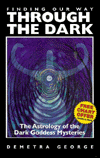
It is thanks to Demetra George, of course, that we have a wealth of material about the asteroid goddesses, especially the four major ones, Ceres, Pallas Athene, Juno and Vesta. Since her groundbreaking work Asteroid Goddesses was published in 1984, these goddess archetypes have taken hold in the astrological community, and have provided us with a much wider range of female archetypes than just the Moon (the mother) and Venus (the sexual companion).
I am currently delving deep into the mysteries of Lunar Progressions and discovering the many Dark Goddess Asteroids in my chart thanks to Demetra's new book Finding Our Way Through the Dark: The Astrology of the Dark Moon Goddesses. In 1992, her Mysteries of the Dark Moon introduced many of us to the concept of the lunar cycle as a model of transformation, with the dark moon phase symbolic of the dark times in our lives. Finding Our Way Through the Dark is a workbook companion to Mysteries, helping us to discover and then interpret these many "dark moon" times.
Although it helps to have some previous knowledge of astrology, Demetra explains her concepts clearly in a way that should be easily understood by the astrological novice. She uses the same workbook format that she introduced in Astrology for Yourself, in which you match the symbolic meaning of a planet or asteroid with the meaning of its sign and house. For example, after a brief discussion of the dark goddess Hekate, she notes that "in chart analysis, the asteroid Hekate shows how I can best access my unconscious and communicate with the spirit realms." Journal questions follow ("Do I ever have foretellings through dreams, vision, voices or sudden insights? Can I honor my extrasensory wisdom or am I frightened when these prophecies come true?"), then instructions on placing Hekate into your chart and "decoding" the meaning. Hekate in Gemini, for example, would indicate that access to the unconscious and spirit realms may come through writing or even talking with others. If the asteroid is found in the 5th house, a person may activate that access to the spirit realms through creative projects.
Also included are chapters on the mysterious Twelfth House (Mary and Linda with their Twelfth House Suns will both appreciate this material!), Pluto transits, the South Node, void-of-course moons and eclipses. The heart of the
book, however, is the teaching on the eight-fold lunar cycle as a model of transformation. The eight phases of the moon are clearly discussed in regard to personality characteristics of the natal moon phase. I was born under a First Quarter Moon, a phase that is characterized by crisis and challenge. My life so far has indeed been a series of crises, to which I hope I have responded with strength and grace. I am considering the idea that I may have a tendency to create crises in order to get that adrenaline rush that comes from "being good in a crisis."
I find the teaching on the Lifetime Lunar Phases to be fascinating. This involves the use of an astrological technique called progressions to allow us to clearly see the "lunar blueprint" of our lives. By noting dates and answering journal questions associated with each progressed lunar phase, a pattern of great beauty and mystery begins to emerge in our own life stories. In this issue of TBP beginning on page 20, we have printed an excerpt from Finding Our Way Through the Dark that discusses the nature of the Progressed Balsamic (Dark) Moon Phase, along with instructions on how to determine when that phase may occur in your life.
It took me many years to embrace astrology as one of the tools in my bag of "Wise Woman Arts," but today I wouldn't be without it. Perhaps these books will help you also to unlock the mysteries of the stars.
~review by Joanna Colbert
Author: Demetra George
ACS Publications, November 1995
352 pgs., $16.95
